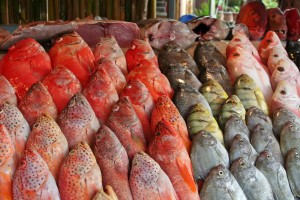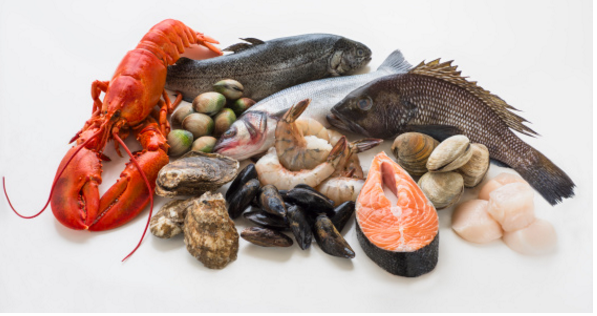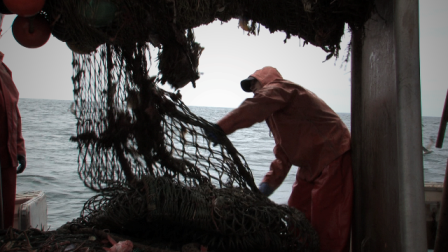By Catharine L. Kaufman—a.k.a. The Kitchen Shrink
When I was pregnant, the local fishmonger refused to sell me swordfish, explaining that this humungous, bottom feeding creature was loaded with mercury and PCBs. My subsequent research revealed that the former was found to cause brain damage in both fetuses and young children, and PCBs have been linked to cancer in humans and animals. Needless to say, I’ve been avoiding such potentially toxin-loaded bottom feeders as swordfish, striped bass and eel ever since.
I’ve also been keeping clear of shark, tuna and other giants known to accumulate high levels of mercury in their bodies from eating large quantities of smaller and less contaminated fish.
According to the Natural Resources Defense Council, when shopping for fish and seafood, consumers are advised to select a catch low in contaminants and high in Omega 3 and other nutritional value, while also taking into consideration the species’ existing level of sustainability.
Among the ones listed by the NRDC as containing the lowest amounts of mercury are anchovies, sardines, herring and salmon—for which all of us at FreeRangeClub reserve our top recommendation, with some caveats:
• That they all be wild caught, not farmed (be aware that the designation “wild” by itself without the “caught” could still mean farmed);
• that both the salmon and sardines come whole—meaning with their calcium-rich skin and bones included—and the sardines preferably packed in pure olive oil— (our top choice is the Omega-3-rich Crown Prince brand Brisling sardines from Scotland, as well as a few Norwegian imports);
• that canned salmon also be wild caught (we usually choose the economic 14.75 oz. can of Pink Salmon from Alaska, sold at Whole Foods Markets); and
• that the herring we buy be kept in the store’s refrigerated section, packed in glass jars, with onion slices, in vinegar or wine—and that herring packed in cream sauce be avoided if possible.
Other catch recommended by various sources as low in mercury, include domestic crab, crawfish, North Atlantic chub mackerel, ocean perch, wild caught salmon, calamari (squid), shrimp, Pacific sole, tilapia, whitefish, fresh-water trout, Dungeness crab, sablefish or black cod from Alaskan and Canadian waters, as well as Maine lobster and pink shrimp from Oregon. Salmon and shrimp, alas, have been severely depleted by over-fishing, so don’t be surprised if wild caught are hard to come by.
Fishermen have been sounding the alarm long before consumers became aware of the over-fishing problem. The Pew Environment Group (PEG) is leading the fight for conservation and the rebuilding of endangered fish populations to sustainability levels. Aware of the stakes that fisheries as well as coastal economies have in the success of this rescue mission, the legendary New England fishing industry is fully engaged and lending its expertise and energy to the effort. Organizations such as the Midcoast Fishermen’s Association and New England Fishery Management Council are coming up with creative ways to restore their members’ depleted livelihoods and the viability of fishing fleets.
This spring of 2010, events are organized to help link fishermen with chefs and the food community, to set up a system whereby restaurants, farmers’ markets and other retailers could buy seafood directly from those who catch it. A perfect solution to one of the problems our FRC researchers have been struggling with: Providing consumers with reliable information about where, when and under what conditions was their fish caught, handled and stored.
But since most of us don’t live in New England, we must rely on reports from—we hope—reliable sources about the safety of various seafood. For example, our research shows that Alaskan cod, halibut, mahi-mahi, lobster, monkfish, sable and snapper have ‘moderate’ levels of mercury—which warns me to serve these choices no more than twice a month. It’s good to know that such caution and restraint will actually help these over-fished species to recover and become a sustainable food source again.
To my great regret, however, I’ve had to completely give up eating such favorites of mine as grouper, Chilean sea bass, yellowfin tuna, orange roughy and bigeye ahi—all because their mercury levels are off the charts.
To compensate for their loss, I’ve learned to adapt some recipes to fool my family’s taste buds. Take my Salmon and Sardines Salad (You can find it in the salads category of our Healthy Recipées section), which I substitute now for the tuna salad most of us grew up with. All the ingredients I combine with the wild caught salmon and sardines are organic —not only because they are healthier and more nutritious, but also noticeably better tasting.
If you are a fishing enthusiast who likes to catch your own in coastal waters, be mindful of sewer breaks and other pollution alerts before casting those lures. Best to check your state or regional advisories, too.
What’s Different About Farm-Raised Fish & Seafood? Growing demand for fish and seafood has led to over-fishing that has driven some once plentiful species to the brink of collapse. Scarcity and the promise of higher profits have prompted the establishment of commercial aquatic farms consisting of giant nets and other environments in which fish and various kinds of seafood are raised. Unfortunately, many of these farms are overcrowded, necessitating the use of fungicides, antibiotics and other medications to keep the stock alive and in reasonably presentable shape for sale. Feeding the stock cheap, toxic and often inappropriate foods that cause biological anomalies in the farmed species, further increases profitability.
Some aquatic farms are run with conscientious efforts to raise healthy stock with high nutritional values, while others cut corners and shortchange their customers. So let’s use our purchasing power to influence the industry to improve its practices by avoiding farm-raised fish and asking retail fishmongers to post their suppliers names.
Brain Food — Convinced that fish was “brain food,” my Mom cooked seafood feasts several times a week, in the firm belief that it would make me a straight-A student. It worked—or I had just worked harder to hide my suspicion that this was an old wives’ tale. But since recent studies have proved my mother right, I’m cooking up a storm of Omega-3-loaded fish and seafood dishes to help my kids ace their SATs.
Got to admit I’m also psyched by reports about the beneficial (read, rejuvenating) effects a fish-rich diet has on the aging brain—not to mention the protection Omega-3 fatty acids confer upon our cardiovascular systems. Brilliance and heart-health is well worth the small effort it takes to make informed (wild caught) choices and cook up creative recipes for our twice a week, family fish-fests.
 The World Is Your Oyster—Except in Months Without “R”s — The rule of thumb that certain shellfish should not be consumed in months that have no “R” in the names—i.e., May through August—probably arose because of the pesky summer blooms of toxic red algae known as “red tide,” that overrun coastlines and poison oysters, clams, mussels and everyone and everything that eats them. One frequently hears of food poisoning outbreaks among people who ate locally harvested shellfish, especially along the Pacific coast. So be super-careful when consuming shellfish in the summertime.
The World Is Your Oyster—Except in Months Without “R”s — The rule of thumb that certain shellfish should not be consumed in months that have no “R” in the names—i.e., May through August—probably arose because of the pesky summer blooms of toxic red algae known as “red tide,” that overrun coastlines and poison oysters, clams, mussels and everyone and everything that eats them. One frequently hears of food poisoning outbreaks among people who ate locally harvested shellfish, especially along the Pacific coast. So be super-careful when consuming shellfish in the summertime.
The U.S. Fisheries and Aquaculture Department assures us that farmed mussels are actually safer than wild ones found in the salty (and sometime contaminated) waters of the Pacific and Atlantic, since mussel farmers maintain clean environments and provide their filter-feeder shellfish with appropriate, non-toxic food that is free of chemicals. While so far we have no contrary information, I for one tend to take such generalized claims with several grains of caution. My standing advice for eating these bivalves is: Moderation. Also, stop eating at the slightest twinge of discomfort.
Fish Tips:
1) Whether live, fresh (shucked), frozen, cooked or smoked, always buy shellfish and finfish from reputable markets.
2) Since PCB’s and other contaminants are mostly stored in the fatty tissues of fish, peel away the skin where the fat is abundant, and grill so the fat renders off. Deep-frying is not only a very unhealthy choice from the get-go, but it seals in toxins as well. 3) When cooking bivalves, the shells should open within 5 minutes. If not, chuck it.
4) Refrigerate seafood immediately when you get home and cook and eat it within two days. Live lobster and crab should be cooked the day of purchase.
5) Seafood and fish should be cooked like Baby Bear’s porridge— just right. Crustaceans become rubbery when overcooked, unsafe and mushy when undercooked. Generally, cooking fish as opposed to eating it raw or rare will reduce contamination levels by 30 or more percent.
As a consolation prize for burdening you with caveats and safety tips, click here for my favorite recipe of fresh Asian Salmon Cakes—found under Entrées in our Recipes With Pizzazz section. You won’t have to fish for compliments with this one.
For comments, critiques or more recipes, feel free to e-mail me here at our FreeRangeClub site ([email protected]), or directly at [email protected]



6 Comments on “Safe & Tasty Choices in Fish & Seafood”
shoot cool info dude.
Seafoods are very rich in Iodine too.’**
seafoods are great because they have lots of the mineral iodine which prevents goiter.*-
the thing i love about seafoods is that salty fishy taste, seafoods are rich in iodine too`:`
well, who does not love seafood anyway? Seafood tastes so yummy and is addicting~”:
seafoods are great because they are really tasty, i think that almost all seafoods are super duper tasty ‘:,